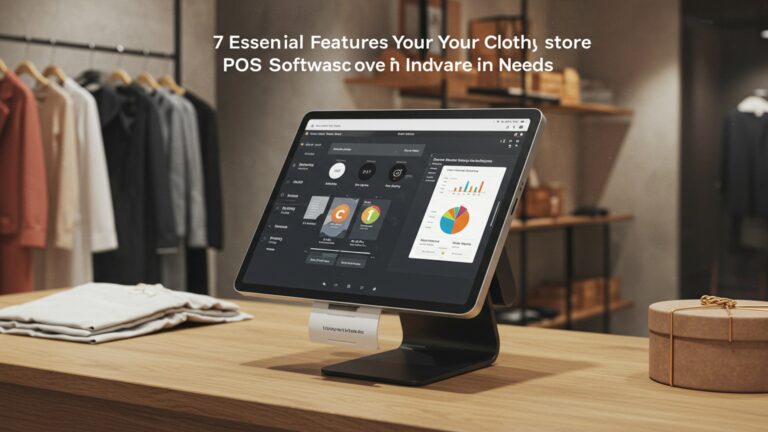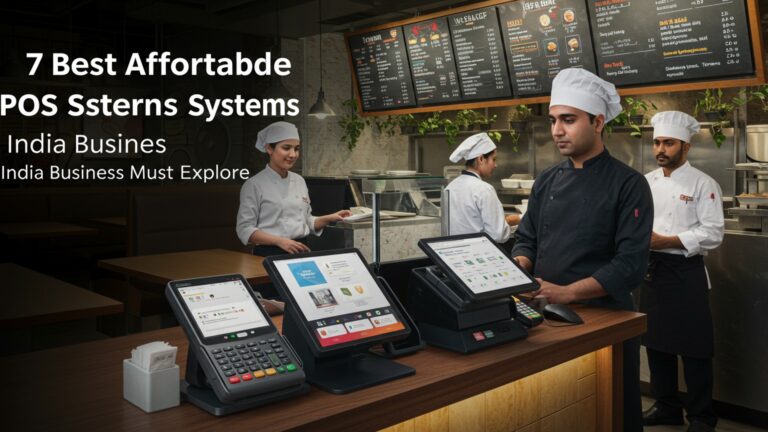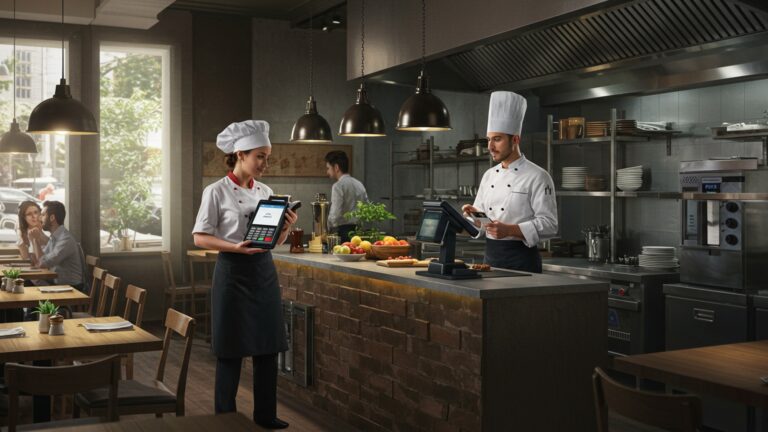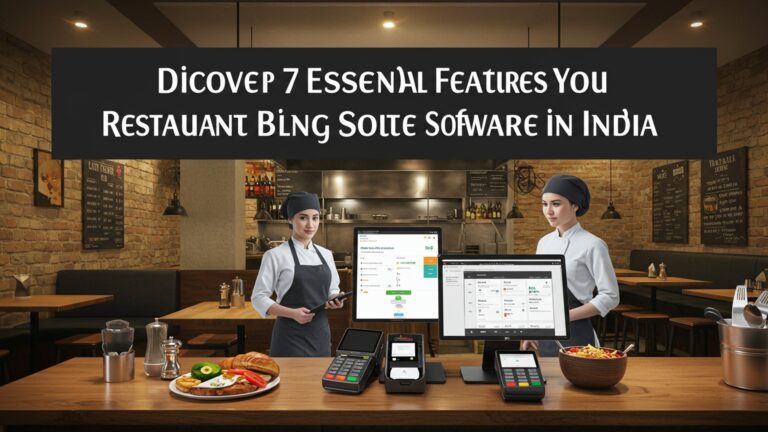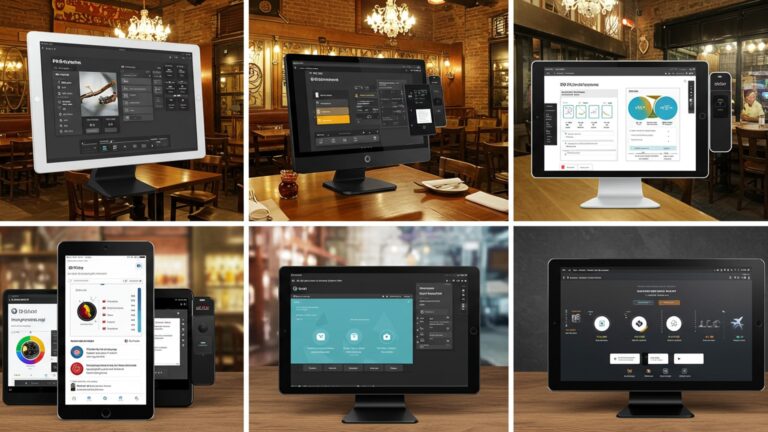7 Essential Features Your Restaurant POS System Needs for Small India Businesses
For small restaurants in India, navigating the complexities of daily operations—from managing peak hour rushes and diverse payment methods to controlling inventory—demands more than just traditional billing. A robust Restaurant POS system for small restaurants India is no longer a luxury but a strategic necessity, transforming chaotic order taking into seamless transactions and enhancing customer satisfaction. Modern systems offer crucial integrations, like UPI payments and direct online ordering from platforms such as Swiggy and Zomato, centralizing sales data and reducing manual errors. Embracing a feature-rich POS empowers owners to gain real-time insights into sales trends and inventory levels, optimizing food costs and improving overall profitability in a competitive market.
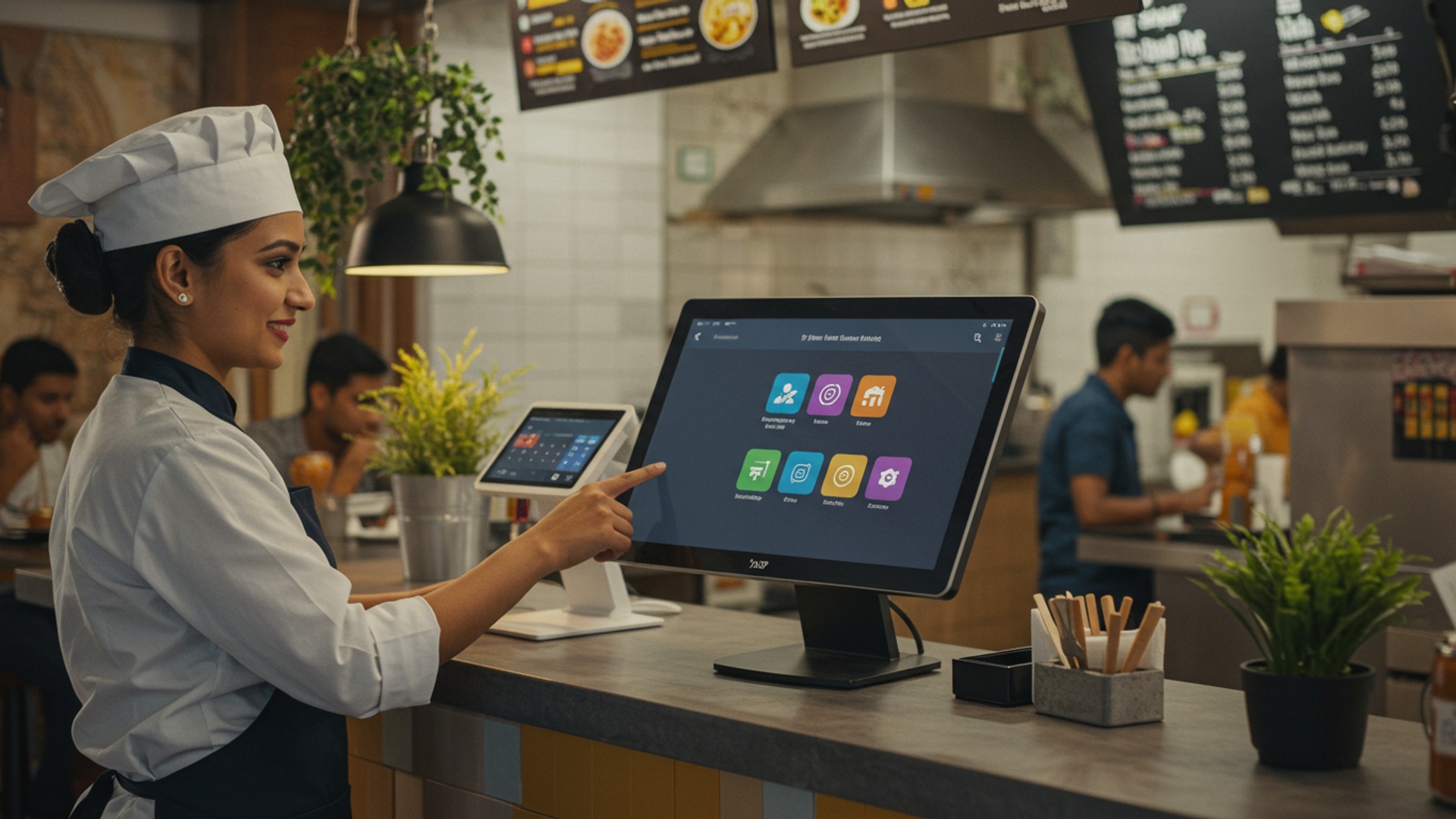
1. Intuitive Order Management and Table Layout
At the heart of any bustling eatery is the ability to take orders quickly and accurately. For a small restaurant in India, an intuitive order management system is not just a convenience; it’s a necessity for smooth operations and customer satisfaction. This feature encompasses everything from taking orders at the table or counter to sending them directly to the kitchen or bar.
An intuitive order management module allows staff to easily input customer orders, customize items (e. g. , “extra spicy,” “no onion”). manage tables. A visual table layout feature lets staff see which tables are occupied, available, or awaiting service, streamlining seating and service flow.
- Reduced Errors
- Faster Service
- Improved Staff Efficiency
- Customization Handling
Manual order taking is prone to mistakes, leading to food waste and unhappy customers. A digital system minimizes these errors.
Orders are instantly transmitted to the kitchen, cutting down preparation time and improving table turnover, crucial for maximizing revenue in a small space.
Waitstaff can focus more on customer interaction rather than deciphering handwritten notes.
Indian cuisine often involves numerous modifications. A robust system handles these requests seamlessly, ensuring customer preferences are met.
Imagine a small South Indian tiffin center during peak breakfast hours. With a visual table layout, the manager can quickly assign new customers to available tables. Waiters, using a tablet-based Restaurant POS system for small restaurants India, can punch in orders for dosas, idlis. vadas with specific modifications, which immediately appear on the kitchen display system (KDS). This prevents confusion, speeds up service. keeps customers happy.
2. Robust Inventory Management and Waste Reduction
Food costs are a significant concern for any restaurant, especially for small businesses operating on tight margins. Effective inventory management is the secret sauce to controlling these costs and minimizing waste. A good Restaurant POS system for small restaurants India should offer comprehensive tools to track ingredients from procurement to plate.
This feature allows you to track all your raw materials (vegetables, spices, dairy, meat, etc.) and finished goods in real-time. It includes functionalities like tracking stock levels, setting reorder points, managing suppliers. monitoring ingredient consumption based on sales.
- Cost Control
- Reduced Spoilage
- Recipe Management
- Supplier Management
Prevents over-ordering and identifies pilferage, directly impacting your bottom line.
By tracking expiry dates and consumption patterns, you can minimize food spoilage, a major financial drain for fresh ingredient-heavy Indian cuisine.
Link recipes to inventory to automatically deduct ingredients as dishes are sold, providing accurate consumption data.
Keep records of suppliers, purchase orders. pricing, ensuring you get the best deals.
Utilize the POS system to conduct daily or weekly inventory checks. Compare actual stock levels with what the system indicates should be present based on sales. Discrepancies can highlight issues like portion control problems, spoilage, or even theft, allowing you to address them promptly. For example, if your system shows you should have 10 kg of rice left but you only have 8 kg, it prompts investigation.
3. Seamless Billing and Diverse Payment Processing
In today’s digital age, customers expect flexible and secure payment options. For a small restaurant in India, a POS system that offers seamless billing and integrates with various payment gateways is non-negotiable. This feature ensures quick checkout and caters to diverse customer preferences.
This module handles generating accurate bills, applying discounts, splitting bills. processing payments. Crucially, it should support a range of payment methods common in India, including cash, debit/credit cards, UPI (Unified Payments Interface) apps like Google Pay and PhonePe. digital wallets.
- Customer Convenience
- Faster Transactions
- Accuracy and Transparency
- Reconciliation
Offering multiple payment options enhances the customer experience and reduces friction at checkout.
Digital payments are quicker than handling cash, especially during busy periods, leading to better table turnover.
Automated billing eliminates human errors in calculations and provides customers with clear, itemized bills.
Integrated payment processing simplifies daily reconciliation, making accounting much easier for small business owners.
| Payment Method | Pros for Restaurants | Cons for Restaurants |
|---|---|---|
| Cash | No transaction fees, immediate settlement. | Handling cash (change, security risks), reconciliation effort. |
| Debit/Credit Cards | Widely accepted, higher transaction limits, integrated with POS. | Transaction fees (MDR), settlement delays. |
| UPI (Google Pay, PhonePe, etc.) | Low/no transaction fees, instant settlement, popular in India, QR code based. | Can require manual confirmation for some systems, internet dependency. |
| Digital Wallets | Convenient for customers, often integrated with loyalty programs. | Can have transaction fees, less universal than UPI. |
A good Restaurant POS system for small restaurants India will integrate with a payment gateway that supports all these methods, allowing you to accept payments directly through the POS terminal or a linked device.
4. Comprehensive Reporting and Analytics
What gets measured gets managed. For small restaurant owners, understanding performance metrics is vital for making informed decisions, identifying trends. optimizing operations. A robust POS system provides detailed reports and analytics that act as your business’s compass.
This feature generates various reports on sales, inventory, popular dishes, staff performance, peak hours. more. It translates raw transaction data into actionable insights, often presented through dashboards and customizable reports.
- Identify Best-Sellers and Slow-Movers
- Track Sales Trends
- Evaluate Staff Performance
- Profitability Analysis
- Marketing Decisions
Helps optimize your menu, reducing waste and focusing on profitable items.
comprehend daily, weekly. monthly sales patterns to better manage staffing, inventory. promotions.
Monitor individual staff sales and efficiency, identifying training needs or rewarding top performers.
interpret which dishes are most profitable by linking sales data with ingredient costs from inventory.
Data on peak hours and popular items can inform targeted marketing campaigns and promotions.
A small café owner uses their Restaurant POS system for small restaurants India to discover that their filter coffee sales surge between 8 AM and 10 AM, while their sandwiches are popular during lunch. This data helps them schedule more baristas in the morning and prep more sandwich ingredients for midday, preventing stockouts and maximizing sales during peak times.
5. Integrated Customer Relationship Management (CRM) and Loyalty Programs
Building a loyal customer base is crucial for the sustained success of any small restaurant. An integrated CRM and loyalty program within your POS system can turn first-time visitors into regulars and significantly boost repeat business.
This feature allows you to collect customer details (names, contact details, purchase history), manage loyalty points or reward programs. communicate directly with customers. It’s about personalizing the dining experience and encouraging repeat visits.
- Increased Repeat Business
- Personalized Marketing
- Improved Customer Experience
- Gather Feedback
Loyalty programs incentivize customers to return, offering discounts, free items, or exclusive offers.
Use purchase history to send targeted promotions (e. g. , “We noticed you love our biryani – here’s a discount on your next order!”).
Recognizing returning customers and their preferences (e. g. , “Welcome back, Mr. Sharma, your usual chai?”) creates a memorable experience.
Use the CRM to send surveys or solicit feedback, helping you continuously improve.
A family-run pizzeria in Mumbai implements a loyalty program through their Restaurant POS system for small restaurants India. Customers earn points for every rupee spent. Once they accumulate enough points, they can redeem them for a free pizza. The POS also tracks their favorite toppings, allowing the restaurant to occasionally send personalized SMS offers, like “Try our new Paneer Tikka pizza, just like your favorite Veggie Supreme!” This builds community and keeps customers coming back.
6. Efficient Staff Management and Permissions
Your staff are the backbone of your restaurant. An effective POS system should simplify staff management, ensuring smooth operations and preventing unauthorized actions. This is particularly essential for small businesses where every team member’s role can significantly impact overall efficiency.
This module allows you to manage employee profiles, track their clock-in/clock-out times, assign roles and permissions. monitor individual sales performance. Role-based permissions ensure that only authorized staff can perform specific actions (e. g. , applying discounts, voiding orders, accessing reports).
- Accountability
- Time & Attendance
- Security
- Performance Monitoring
Track who performed which transaction, reducing errors and potential for theft.
Simplifies payroll processing by accurately tracking employee hours.
Restrict access to sensitive functions (like refunds or financial reports) to managers only, enhancing security.
Identify top-performing staff members and those who might need additional training, based on sales data.
Set up clear user roles within your Restaurant POS system for small restaurants India. For instance, waiters might have permissions to take orders and process basic payments, while managers can access all reporting, inventory adjustments. discount approvals. Regularly review these permissions to ensure they align with staff responsibilities and security protocols.
7. Seamless Third-Party Integrations (Online Ordering & Delivery)
The digital landscape of food service in India has exploded, with online ordering and food delivery platforms becoming indispensable. A modern Restaurant POS system for small restaurants India must integrate seamlessly with these third-party services to capture the growing off-premise dining market.
This feature enables your POS system to communicate directly with popular online food aggregators (like Zomato, Swiggy, Dunzo), your own online ordering website, or even accounting software. Orders placed through these platforms are automatically pushed to your POS. often, inventory and menu updates can be synced across all channels.
- Expanded Reach
- Streamlined Operations
- Centralized Management
- Real-time Menu Updates
- Data Consistency
Access a wider customer base beyond your physical location.
Eliminates the need for multiple tablets and manual order entry, reducing errors and increasing efficiency.
Manage all orders (dine-in, takeout, delivery) from a single system, simplifying kitchen operations.
Easily update menu items, prices. availability across all platforms from your POS.
Ensures that sales data from all channels is consolidated for accurate reporting and inventory management.
A small, traditional Indian sweet shop decides to embrace online delivery. They choose a Restaurant POS system for small restaurants India that integrates with Zomato and Swiggy. When a customer orders a box of gulab jamuns online, the order automatically appears on the sweet shop’s POS terminal and kitchen display. This eliminates the need for staff to manually re-enter orders, significantly reducing errors and speeding up order fulfillment, allowing them to manage both walk-in and online orders effortlessly from one place.
Conclusion
The journey to elevate your small Indian restaurant isn’t just about delicious food; it’s increasingly about smart operations. We’ve explored the essential features that transform a basic billing system into a strategic partner, from managing complex inventory for ingredients like fresh paneer and regional spices to seamlessly handling diverse payment methods, including UPI. My personal tip, drawn from observing countless successful local eateries, is to prioritize a system that offers robust, real-time reporting, allowing you to quickly spot trends – perhaps which Thali sells best on Tuesdays or how a new special impacts your margins. This isn’t merely about tech; it’s about gaining actionable insights to make informed decisions. Remember, the right POS system isn’t an expense. an investment in your restaurant’s future, enabling smoother service, reduced waste. happier customers. Take the initiative to evaluate systems based on your unique menu and customer base, understanding how each feature specifically addresses your operational challenges. For instance, a system that effectively streamlines your restaurant billing software can significantly boost your bottom line. Embrace this digital transformation with confidence. watch your small business thrive in India’s dynamic culinary landscape.
More Articles
How to Choose the Best 7 POS Systems for Your Small Indian Restaurant
Mastering Restaurant POS Software A Comprehensive Guide for Efficient Management
How to Master Inventory Management POS India 10 Strategies for Success
Unlock Efficiency How to Choose Top POS Billing Software for Your Business
7 Smart Ways Restaurant Billing Software India Boosts Your Profits
FAQs
Why should my small Indian restaurant even bother with a POS system?
A good POS system is a game-changer for small Indian restaurants! It helps you manage orders, payments. inventory much more efficiently. This means faster service, fewer mistakes, better tracking of what’s selling. ultimately, more profit and happier customers. It takes a lot of manual work off your plate.
What’s the big deal with KOT/BOT (Kitchen/Bar Order Ticket) features?
KOT/BOT functionality is super vital! It streamlines communication between your front-of-house staff and the kitchen/bar. Orders go directly and accurately, reducing errors, speeding up preparation. ensuring everyone knows exactly what needs to be made. It’s crucial for smooth operations, especially during busy hours.
Can a POS system really help me keep track of all my ingredients and stock?
Absolutely! A robust POS system includes inventory management features. You can track ingredients, monitor stock levels in real-time, get alerts for low stock. even manage recipes. This helps reduce wastage, control costs. ensures you never run out of popular items, which is vital for profitability.
How does a POS make billing and payments easier for customers in India?
Modern POS systems are designed for the Indian market, supporting multiple payment methods like cash, cards, UPI. various digital wallets. They also make splitting bills easy, applying discounts. even managing loyalty points. This offers flexibility to your customers and speeds up the checkout process, improving their experience.
What kind of useful reports can I actually get from a restaurant POS?
You get a ton of valuable insights! A good POS provides reports on sales trends, popular dishes, peak business hours, staff performance. even inventory consumption. These reports help you make smarter decisions about menu planning, staffing, marketing. identifying areas where you can cut costs or boost revenue.
Does a POS help with managing my tables and customer flow for dine-in?
Yes, definitely! Many POS systems come with table management features. You can see a visual layout of your restaurant, check table status (occupied, vacant, cleaning), manage waitlists. assign orders to specific tables. This helps improve efficiency, reduce wait times. enhance the overall dine-in experience for your patrons.
My restaurant does a lot of deliveries and takeaways. Can a POS help with that too?
For sure! A good POS system integrates seamlessly with online ordering platforms and helps manage your delivery and takeaway operations. You can track orders from preparation to dispatch, manage delivery personnel. keep customers updated. This ensures smooth, efficient handling of off-premise orders, which is a growing part of the business.

